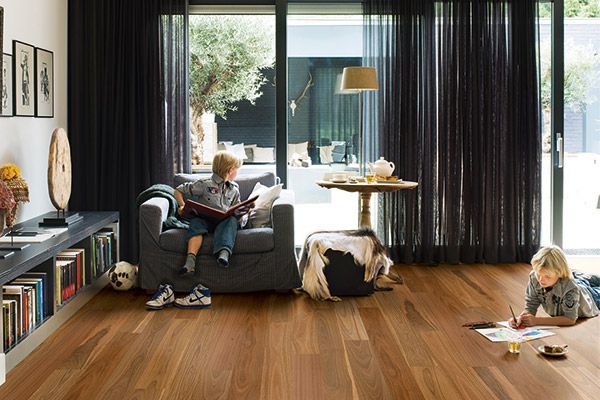The past 10 years has seen an explosion in the number and styles of wood flooring systems available to developers, designers and specifiers, with engineered wood emerging as a design favourite.

June 30th, 2016
The complexity and diversity in modern wood flooring options poses a challenge for designers in trying to stay across the ranges of benefits, features, pros and cons of this sector. Ease of installation, durability, multi-storey noise performance and above all beauty, are just some of the questions in the minds of both clients and specifiers.
Overwhelmingly though, it is engineered wood flooring, also called multi-layer wood flooring, that is being used in the majority of contemporary residential and commercial projects. This can be attributed to the dimensional stability, speed of installation, reliability and versatility of engineered wood.
Engineered wood components have become favoured over solid wood products across building trades and flooring products. Some of the specific advantages of Quick-Step engineered wood flooring over traditional solid flooring options include…
The Premium Floors range of Quick-Step engineered wood flooring offers designers the versatility to float or direct stick when installing.
Floating installations are less expensive and faster to install, and provide superior reduction of impact noise. While there is sometimes apprehension in specifying a floating installation, due to possible movement underfoot, the selection of Premium Floors’ Quiet-Step underlays actually results in a floating installation with a solid feel and reduced foot-fall noise.
Premium Floors
premiumfloors.com.au
INDESIGN is on instagram
Follow @indesignlive
A searchable and comprehensive guide for specifying leading products and their suppliers
Keep up to date with the latest and greatest from our industry BFF's!

BLANCOCULINA-S II Sensor promotes water efficiency and reduces waste, representing a leap forward in faucet technology.

Gaggenau’s understated appliance fuses a carefully calibrated aesthetic of deliberate subtraction with an intuitive dynamism of culinary fluidity, unveiling a delightfully unrestricted spectrum of high-performing creativity.

How can design empower the individual in a workplace transforming from a place to an activity? Here, Design Director Joel Sampson reveals how prioritising human needs – including agency, privacy, pause and connection – and leveraging responsive spatial solutions like the Herman Miller Bay Work Pod is key to crafting engaging and radically inclusive hybrid environments.

In this candid interview, the culinary mastermind behind Singapore’s Nouri and Appetite talks about food as an act of human connection that transcends borders and accolades, the crucial role of technology in preserving its unifying power, and finding a kindred spirit in Gaggenau’s reverence for tradition and relentless pursuit of innovation.

“We connect with the Chin Chin customer through materiality. You would expect to see the chipboard substrate cladding in a twenty-something’s apartment. It’s raw and youthful and in that sense makes a relationship with the Chin Chin majority diner” says George Livissianis.

Global design fairs usually occupy dull exhibition halls, where besuited visitors trudge down rows of same-same stands. SO. BORING. This is why every year at Sydney Indesign, we turned things up a notch at The Venue: one location with one enormous lineup! And it was truly stellar…
The internet never sleeps! Here's the stuff you might have missed

Mizzi Studio has completed The Living Bridge, a regenerative education and co-learning space at Green School Bali.

This new book tells resident stories about how good design creates liveable, high-density homes with socially led developer Neometro.